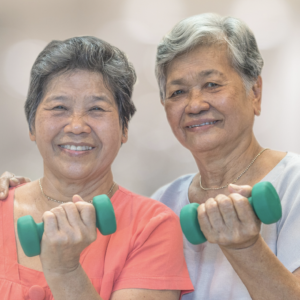Better Late Than Not At All: Exercise No Matter Your Age

Better Late Than Not At All: Exercise No Matter Your Age
January 24, 2024
You’d be forgiven if you think that the older you get, the less important it is to exercise. After all, your joints begin to hurt, your strength begins to wane, etc. Isn’t this nature’s way of telling us to slow down and take it easy as we get older? However, the less you do, the less you’re able to do going forward. And that’s precisely the problem. You get into a vicious cycle of moving less, doing less, and then being unable to do more. But this is a trap, a potentially deadly trap. Even though it’s estimated that over 35% of adults 75 and older are physically inactive, there’s nothing normal or inevitable about this. And, in fact, there’s increasing evidence that this inactivity later in life is putting you at a distinct disadvantage when it comes to cardiovascular disease, still the number one killer of American adults.
According to new research published in The British Journal of Sports Medicine, researchers at Mass General Hospital were able to determine that a lack of physical activity during your free time greatly increases your risk of dying from heart disease. Of particular risk were middle-aged women and older Black adults, both of whom face innumerable barriers to exercising in their daily lives, including caregiving responsibilities, stress, socioeconomic factors, etc. To find out more about this study, take a quick break and read here. And if you’re feeling unmotivated to put in the effort each day to exercise, there is additional new research out of Iowa State University (published in The European Heart Journal) that suggests a slightly easier way to get it done every day. According to this research, if you cut in half your daily aerobic exercise (maybe your walk, or a treadmill jog, or a dance class) and instead replace it with some resistance training, you’ll accomplish the same level of cardiovascular benefits as you would from a full court press of cardio. While more research is needed, and this is not an excuse to drop the cardio, it does suggest that you can mix things up a bit and still do good for your heart. For more on this research, pick up a resistance band and read here.
How do you know how much exercise you’re able to do at this point in your life? You know how old you are by the calendar, but how old is your body? Regardless of how many times you’ve gone around the sun, are you fit enough to do an intense exercise routine? Or has your body aged faster than your birth date, meaning biologically you’re older than your actual age and you need to take steps to rectify that? With a simple online Norwegian test, you can get a sense of your body’s “fitness” age, and then use exercise and physical exertion to get yourself “younger” biologically. For more on this concept of “your fitness age,” read this recent post from Gretchen Reynolds in The Washington Post. For some extra motivation, you may want to read about 93-year-old Richard Morgan, a world champion rower who only started exercising in his 70s and now has the biological profile of an athlete decades younger. Mr. Morgan has been the subject of scientific study and he’s a living example of why, even at an older age, there’s good reason to step it up and exercise. He started aerobic and strength exercises, and now has a simple daily workout routine of about 40 minutes of rowing, and uses dumbbells and his body weight 2-3 days a week for strength training. It’s not a crazy routine and the results demonstrate that “the human body maintains the ability to exercise at any age.” You may not end up as a world-class athlete, but you will help your heart and your body stay healthier as you enter your later years.







